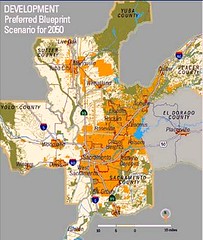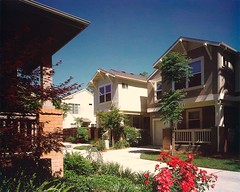Sacramento’s blueprint for orderly development

Posted July 14, 2008 at 8:07PM
Sacramento is making a strong bid to join the pantheon of places in North America that are giving the planning profession a good name. Like Portland, Toronto, and Arlington before it, the Sacramento region is positioning itself to secure its future as a haven of walkable, livable neighborhoods connected by good transportation options, not as a morass of gas-guzzling, budget-busting sprawl.
 The region’s “Blueprint” transportation and land use study, a multi-year joint effort of the Sacramento Council of Governments (SACOG) and its civic partner Valley Vision, is explicitly built around smart growth principles. It was authorized by the SACOG board in 2004 and sets goals and standards to guide development through 2050, when the region is anticipated to have grown by 1.7 million additional people and a million additional jobs.
The region’s “Blueprint” transportation and land use study, a multi-year joint effort of the Sacramento Council of Governments (SACOG) and its civic partner Valley Vision, is explicitly built around smart growth principles. It was authorized by the SACOG board in 2004 and sets goals and standards to guide development through 2050, when the region is anticipated to have grown by 1.7 million additional people and a million additional jobs.
The map accompanying this post outlines the plan: areas in orange either are already or will be developed; areas in green will be preserved as open space parks or environmentally sensitive land; and areas in beige will be primarily for agriculture. Compared to a “base case” that would occur without the Blueprint, 13 percent of all new housing and 10 percent of all new jobs would be directed to reinvestment in currently vacant properties and underutilized areas.
The Blueprint will eliminate a lot of sprawl. Where new development occurs, it will be built to make more efficient use of land, claiming 304 square miles of currently undeveloped land, less than half of the 661 square miles that would be claimed under the base case. 102 square miles of currently agricultural land will be converted to development, instead of 166 square miles under the base case. Yet 65 percent of the region’s housing will remain in single-family homes and farmhouses, very close to the 71 percent of current housing in those categories. (This should be fully consistent with market forces, since changing demographics are already shifting demand in favor of more small-lot and multi-family homes.)
 The Blueprint also contains guidelines designed to encourage walkable streetscapes, homes closer to jobs and amenities, and transportation choices. The goal is for 41 percent of new jobs and 38 percent of new homes to be transit-accessible, which will be a radical improvement over the 5 percent and 2 percent, respectively, anticipated under the base case. Per capita carbon emissions will reduce 15 percent compared to business as usual.
The Blueprint also contains guidelines designed to encourage walkable streetscapes, homes closer to jobs and amenities, and transportation choices. The goal is for 41 percent of new jobs and 38 percent of new homes to be transit-accessible, which will be a radical improvement over the 5 percent and 2 percent, respectively, anticipated under the base case. Per capita carbon emissions will reduce 15 percent compared to business as usual.
The details of the Blueprint may be found here and especially here, and there is an excellent article in the Wall Street Journal that gives the flavor of how it happened and what local acceptance has been. Architect David Mogavero, whose firm designed the highly successful Sacramento smart-growth developments Metro Square and Southside Park Co-Housing (both pictured with this post), is quoted as observing that "expensive oil is going to transform the American culture as radically as cheap oil did," bringing more and more support to the Blueprint concept. NRDC research in 2000 indicated that residents of Metro Square, because of its location and design, would be expected to drive 50 percent fewer miles than residents of a conventional suburban development, and walk four times as much.
 Unlike the situation in Toronto, the Sacramento Blueprint does not have the force of law. Municipalities will have to continually renew their commitment to compliance. But, given the need to reduce carbon emissions, gasoline prices that are unlikely to fall again to low levels, and the need to accommodate growth without choking the region in traffic and pollution, the plan’s chances of success appear good. It has won a slew of honors from such institutions as the US Environmental Protection Agency, Harvard University’s Kennedy School of Government, the Association of Metropolitan Planning Organizations, The Federal Highway Administration, the American Lung Association, and the American Institute of Architects.
Unlike the situation in Toronto, the Sacramento Blueprint does not have the force of law. Municipalities will have to continually renew their commitment to compliance. But, given the need to reduce carbon emissions, gasoline prices that are unlikely to fall again to low levels, and the need to accommodate growth without choking the region in traffic and pollution, the plan’s chances of success appear good. It has won a slew of honors from such institutions as the US Environmental Protection Agency, Harvard University’s Kennedy School of Government, the Association of Metropolitan Planning Organizations, The Federal Highway Administration, the American Lung Association, and the American Institute of Architects.
Indeed, a bill is currently pending in the California legislature to institute Blueprint-style planning statewide. As noted in a post last week, my NRDC colleagues in California are supporting that bill vigorously, and it seems to make all the sense in the world.